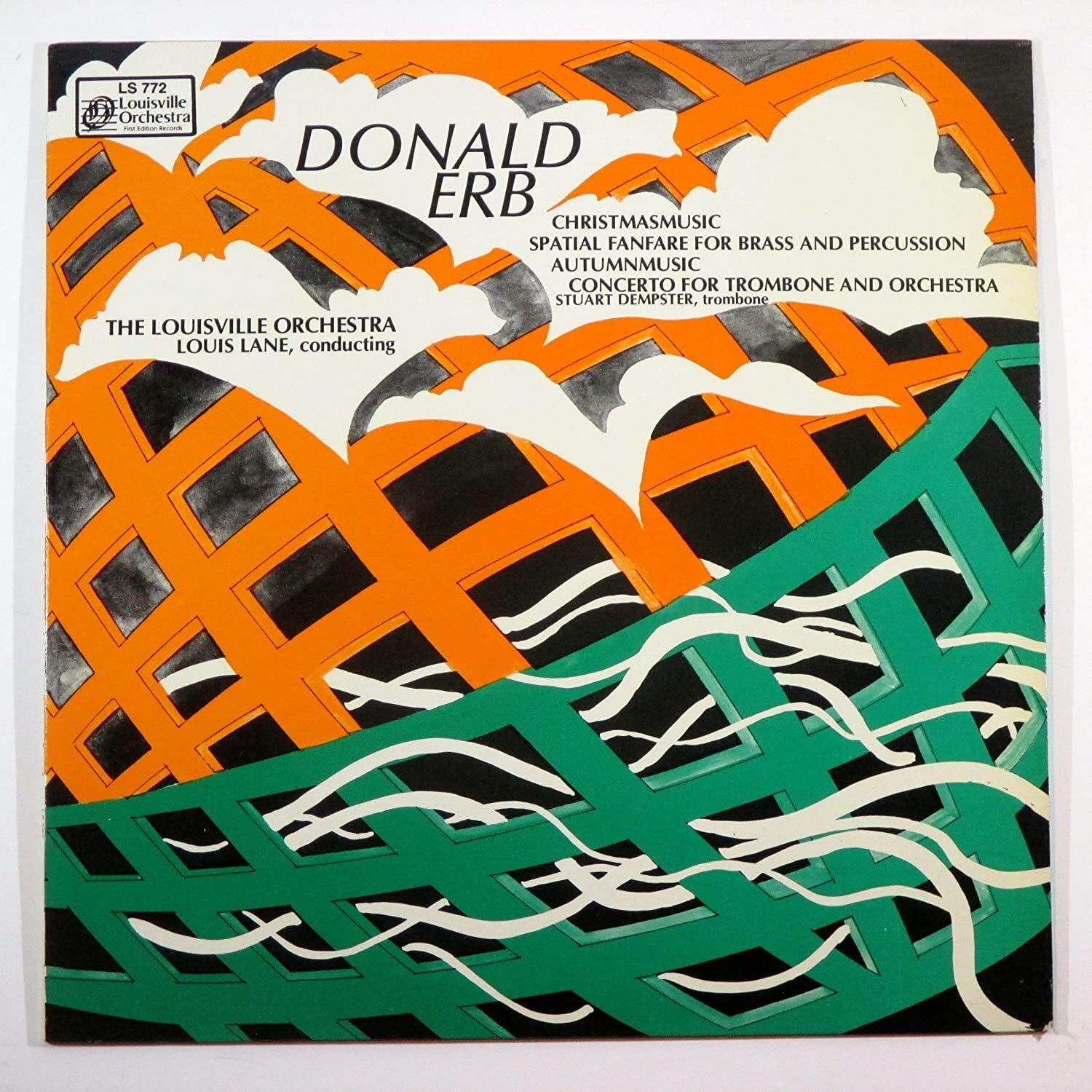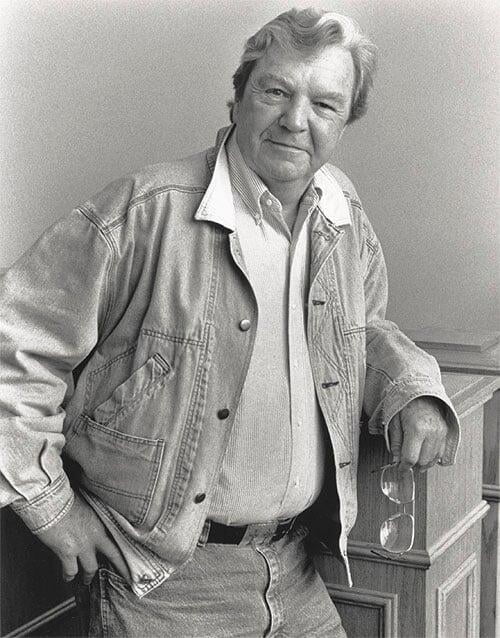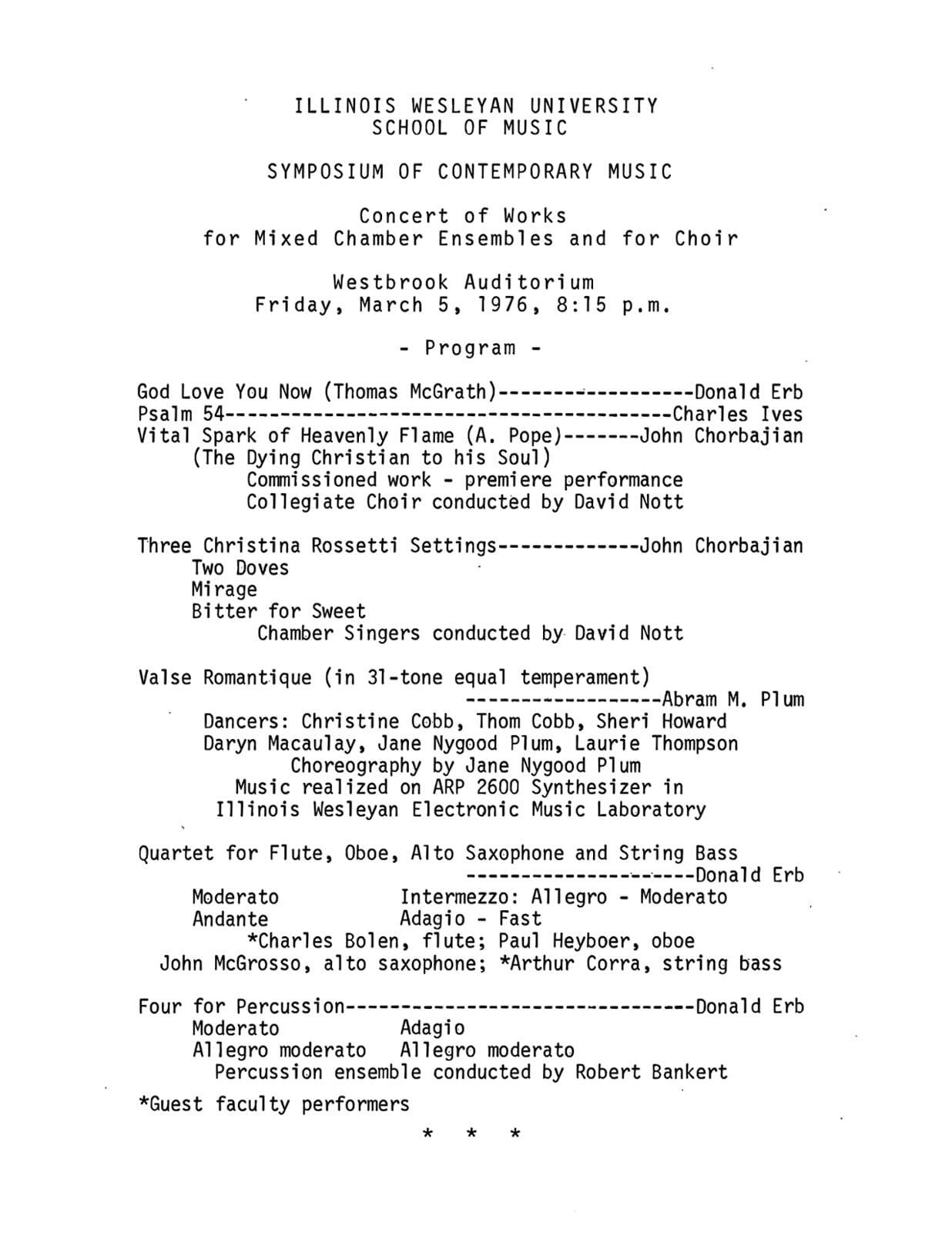
Symposium of Contemporary Music at IWU, 1976
Links to Part 1 and Part 2. Music of the Month to listen to Erb's music is HERE.
I became exposed to a wide variety of music while in college. I had music major friends and fraternity brothers, so I attended their recitals. Experiencing music in person is the best way to gain appreciation of it. To see and hear the artists create the sounds is a joy to me.
In the Spring of 1976, the IWU School of Music's "Symposium of Contemporary Music" had the composer Donald Erb attend to teach and conduct some of his music.
At one of the concerts, I noticed a Coke bottle underneath many of the performer's chairs. That was quite strange to me, since music performed by people playing stringed instruments should not have need for Coke bottles, I thought.
I was wrong.
They did have need for the Coke bottles, because at one point in their performance they picked up those bottles, which had different amounts of water in them to vary the pitch, and blew into the bottles to make more music!
I was stunned at first. Then I smiled, and laughed with joy. How cool is that! Donald Erb showed me that classical music did not have to mean "stuffy," or somber.
Thank you, Donald Erb.
Concert Program from 1976
RIP Composer and Musical Visionary Donald Erb
In the 1970s, it was not unusual for the name of American composer Donald Erb to be invoked along with that of George Crumb. His 1969 Nonesuch LP Reconnaissance -- never, sadly, issued on CD -- represented one of the first times that a Moog synthesizer was used in conjunction with live instruments; the title work was composed in 1967.
Erb was also noted for his use of graphic elements in his scores and as a teacher of renown. Born in Youngstown, Ohio in 1927, Erb made the Cleveland Institute of Music his home base for most of his career, although he also taught at Indiana University in Bloomington and at Southern Baptist University in Dallas. As a young man, Erb played trumpet in a dance band and, like many other famous American composers, studied in Paris with Nadia Boulanger. Despite his uncompromising and challenging musical style, Erb was also a huge fan of rock singer Elvis Presley; students couldn't help but note that his office at IU was well-stocked with Elvis memorabilia. Erb, an ex-Navy man, was also an early and vocal protester against the Vietnam War, although he eventually had a falling out with the movement that supported this political view.
Sometimes Erb's works employed witty and unconventional titles, such as Symphony of Overtures (1968), In No Strange Land (1968), ...And then toward the end... (1970), Purple-Roofed Ethical Suicide Parlor (1976), and Saint Valentine's Day Brass Quintet (1986). Erb wrote many concertos and was noted for them, one of the most famous being The Seventh Trumpet (1969), a piece that also used synthesizer in addition to a harmonica choir, wine glasses, and water filled jugs; originally given with the Dallas Symphony, it was revived by the Chicago Symphony Orchestra in 1987. Erb's early contact with jazz informed his interest in improvisation, which carried over into his classical compositions, along with the use of electronics and his preference for unusual choices of instrumentation. Donald Erb died in Cleveland Heights, Ohio on August 12; he was 81.
https://www.allmusic.com/blog/post/rip-composer-and-musical-visionary-donald-erb/
Donald Erb, Composer, 1927–2008

Donald Erb, Cleveland’s most illustrious and controversial 20th-century composer, explored fresh sonorities and forged new paths in more than 100 boldly imaginative works. He shocked the audience in 1965 when the Cleveland Orchestra first performed his Symphony of Overtures. At the end, the composer was booed and pelted with pennies.
The audience reaction to Erb’s forward-looking style was also hostile at the 1967 premiere of his Christmas music. Commissioned by conductor Louis Lane and the Cleveland Orchestra, the inventive piece deconstructed the Advent hymn, “O Come, Emanuel,” and required the players to hum, moan, slap mouthpieces, rattle keys and strike water bottles.
During a rehearsal of the Cleveland Orchestra’s next commission, Music for a Festive Occasion (1975), the feisty composer got into an onstage altercation with music director Lorin Maazel. As a result, the ensemble ignored Erb for nearly 15 years.
Numerous other musicians, however, embraced his distinctive style. Major orchestras, leading chamber ensembles and virtuoso soloists performed and recorded his music. The Theodore Presser Company published most of his works. Conductor Leonard Slatkin hailed the composer as a “true, unique, original, recognizable voice.”
Erb’s distinctive musical language skillfully mixes familiar tone colors with electronic sounds and the unexpected timbres of harmonicas, kazoos, police whistles and tuned water glasses. Traditional instrumental techniques are extended with multi-phonics, tongue clicking and chopsticks replacing string players’ bows. Static harmonies erupt in nervous rhythms and explosive outbursts. Zigzagging lines zoom and dive to extremes of pitch and dynamics.
Erb’s mature compositions infuse his signature timbres and textures with deep emotion. Ritual Observances (1991) borrows a sorrowful fragment from Mozart’s Requiem. Evensong (1993), commissioned by music director Christoph von Dohnany iin honor of the Cleveland Orchestra’s 75th anniversary, pays loving tribute to musical friends and concludes with a tongue-in-cheek self-portrait, “Old Bad Man.” Besides these orchestral masterpieces,Erb’s heartfelt later works include Children’s Song (1995), a brief violin duet that pours out the composer’s feelings of grief for the children who were killed in the Oklahoma City bombing. “Jesus Loves Me,” the Sunday School hymn quoted in the somber piece, also appears in String Quartet No. 3 and Sunlit Peaks and Dark Valleys, a tour de force for clarinet, violin and piano.
Born in Youngstown, Ohio, on January 17, 1927, Erb started music lessons at age six with a great-aunt who taught him to play cornet during summer vacations in Kansas. During his teen years, he played jazz trumpet and arranged music for dance bands. After graduating from Lakewood High School, he served in the Navy, and then earned a bachelor’s degree in trumpet and composition from Kent State University, a master’s from the Cleveland Institute of Music and a doctorate from Indiana University. His chief mentors were Bernhard Heiden and 1962 Cleveland Arts Prizewinner Marcel Dick. In addition, he studied briefly with master teacher Nadia Boulanger in Paris. A self-described “foundation bum,” Erb won numerous fellowships, grants and awards. He wrote a definitive essay on orchestration for the Encyclopedia Britannica and served as resident composer at the American Academy in Rome, artist-in-residence at the University of Wollongong in Australia and composer-in-residence for the Dallas and St. Louis symphony orchestras.
Besides his achievements as a leading American composer, Erb made a name for himself as a respected teacher. He was affiliated for more than 40 years with the Cleveland Institute of Music, where he headed the composition department until his retirement in 1996. He also taught at Bowling Green, Indiana and Southern Methodist universities, and he lectured at more than 100 colleges and universities. In his classes, he often gave students advice that summed up his own dynamic approach to the creative process: “Don’t be vanilla.”
http://www.clevelandartsprize.org/awardees/donald_erb.html
